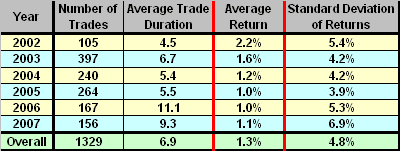A reader asked: “Please evaluate the performances of the The Trend Trade Letter and The Cheap Stocks Letter offered by Befriend the Trend Trading.” We focus here on the The Trend Trade Letter, which has a much larger sample of historical trades than its sibling. Both the company and newsletter names imply a momentum-centric trading approach. The newsletter focuses on fairly continuous short-term technical trading (long and short) of liquid, volatile stocks with no more than ten positions at a time. Based on the information provided on the Befriend the Trend Trading web site, especially the monthly closed trade lists for The Trend Trade Letter (over 1,300 round-trip trades, from inception on 10/7/02 through 12/11/07), we conclude that:
Our first step is to consolidate the many monthly trade lists into a single database for analysis. In grooming the data, we find:
- The November 2002 trade record is a duplicate of that for July 2003 (presumably making subsequent cumulative totals presented on the site incorrect). All the trade exit dates are July 2003, so we delete the November entries, leaving a database of 1,329 round-trip trades.
- About 20 trade dates list the wrong year or wrong month (discovered via negative or extremely long trade durations). We use context to correct these dates, as well as to estimate the trade date for a 1/10/1900 entry.
- Even though the service description states that the newsletter “Trades liquid, volatile stocks priced $15 on up”, we found 228 (mostly older) trades with entry prices below $15.
- As implied by the statement that the service provides “Exact entry and exit prices on all picks”, we assume that all entry/exit prices are actually achieved via limit orders. In a small subsample tested against historical data from Yahoo!Finance, we found average entry and exit prices to be reasonably close to daily high-low midpoints, with considerable variation. However, we had to exclude one exit price that was outside the high-low range for the date indicated. We also found in this small subsample two trade dates that fall on weekends.
- The data apparently excludes trading fees and other costs for short sales.
The large number of errors in the data are troubling. There is no clarifying information on trading assumptions in the company disclaimer, which currently states: “This page is under construction.”
The Trend Trade Letter’s approach is essentially momentum-aided volatility trading. We could measure the timing value of the trade advice by testing whether stock prices move in directions favorable to the trades immediately after trade entry dates. Such a test is very laborious, so we limit this analysis to broader trading statistics.
The following two tables summarize some key statistics for the dataset. Note that:
- Overall average raw trade profitability is 1.3%, but average trade profitability has mostly declined over time. The decline in profitability to the 1% range may be related to overall U.S. stock market behavior. Recall that, with November 2002 data missing, the results for 2002 consist of trades for only October and December of that year.
- The standard deviation of trade returns, one indication of account drawdown risk, is relatively high for 2006 and 2007.
- The average trade duration (calendar days) is relatively high for 2006 and 2007, indicating reduced portfolio turnover and reduced cumulative return, and possibly a bow wave of unprofitable open positions.
- About three quarters of all trades are long, and long trades are generally more profitable than short trades.
- If we exclude trades with an entry price below $15 in conformance with the description of the service, average raw trade profitability declines from 1.3% to 1.2%.


Approximating the overall average raw trade profitability as the average of profitabilities for 2003-2007 (1.16%) and assuming annual portfolio turnover at 20 times, the annual gain before transaction costs is roughly 26%. For comparison, the compound annual return for the S&P 500 index over 2003-2007 is about 11%. Average raw trade profitability might be lower when the broad market is less strong. Also, including open positions that are awaiting profitable exit points may affect overall newsletter profitability.
What happens when we include trading costs (for buy/sell limit orders and cost of borrowing stock for short sales)?
The impact of trading costs depends on trade size. When total round-trip trading costs are 0.65% per trade, the net annual gain for the The Trend Trade Letter under the above assumptions falls to 11%. In a taxable account, this net return would have underperformed buying and holding a broad market index.
To review points from above, investors evaluating such a service should carefully consider:
- For a large number of short-term trades, profitability is very sensitive to actual entry and exit prices. Given the errors discovered and described above, are there undiscovered errors in the trade history that substantially impact actual profitability?
- While the sample is large based on number of trades, it is not diverse in terms of market conditions (basically encompassing one bull market period). Are the decline in average raw trade profitability and the increase in average holding period indications that the strategy may not work well under all market conditions? Said differently, did the strategy have a lucky start date?
- Is there a “bow wave” of open positions (awaiting favorable volatility) that significantly affects overall return?
- Given actual dollars available for equity trading, how much would trading costs reduce raw outperformance?
- How much would capital gain tax affect net outperformance?
In summary, the apparent outperformance of the The Trend Trade Letter may disappear after correcting for trading frictions, market conditions and data errors.